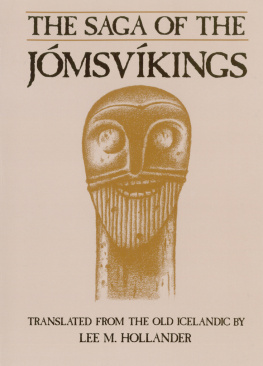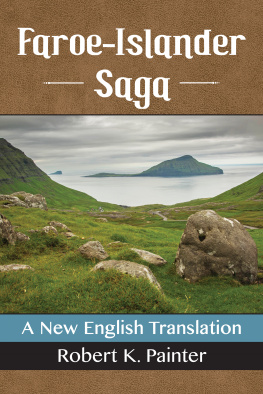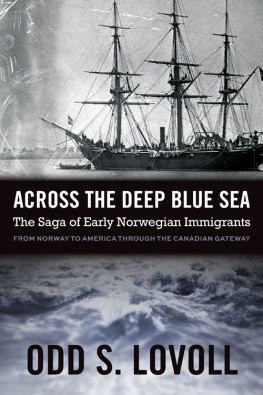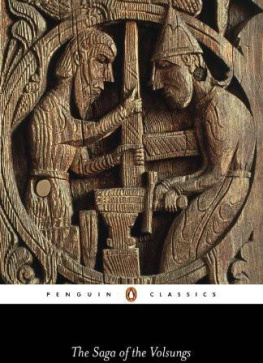
EGIL'S SAGA
SVANHILDUR SKARSDTTIR gained her first degree in Iceland and pursued further studies at the universities of Toronto, Copenhagen and London where she was awarded a Ph.D. for her thesis on a medieval chronicle in the Icelandic manuscript AM 764 4to. She was Lecturer in Icelandic at University College London for six years before taking up a research post at the rni Magnsson Institute in Reykjavik. She has published on Icelandic literature, medieval and modern, and contributed to literary programmes on radio and television. In 2003 she received the Young Scholar of the Year Award from the Icelandic Research Council.
BERNARD SCUDDER was born in Canterbury, Kent, and studied English at the University of York and Icelandic at the University of Iceland. Since 1977 he has lived in Reykjavk, where he is a full-time translator. Including more than a dozen published works, his translations from Icelandic encompass sagas, ancient and modern poetry, and leading contemporary novels and plays. He translated two major sagas for The Complete Sagas of Icelanders (1997) and edited most of the poetry in that collection. In 1998 two novels in his translation were shortlisted for the European Union's Aristeon Literary Prize.
Egil's Saga
Translated by
BERNARD SCUDDER
Edited with an Introduction and Notes by
SVANHILDUR SKARSDTTIR
PENGUIN BOOKS
PENGUIN BOOKS
Published by the Penguin Group
Penguin Books Ltd, 80 Strand, London WC2R 0RL , England
Penguin Group (USA) Inc., 375 Hudson Street, New York, New York 10014, USA
Penguin Books Australia Ltd, 250 Camberwell Road, Camberwell, Victoria 3124, Australia
Penguin Books Canada Ltd, 10 Alcorn Avenue, Toronto, Ontario, Canada M4V 3B2
Penguin Books India (P) Ltd, 11 Community Centre, Panchsheel Park, New Delhi 110 017, India
Penguin Group (NZ), Cnr Airborne and Rosedale Roads, Albany, Auckland 1310, New Zealand
Penguin Books (South Africa) (Pty) Ltd, 24 Sturdee Avenue, Rosebank 2196, South Africa
Penguin Books Ltd, Registered Offices: 80 Strand, London WC2R 0RL , England
www.penguin.com
Translations first published in The Complete Sagas of Icelanders (Including 49 Tales), I and II, edited by Viar Hreinsson (General Editor), Robert Cook, Terry Gunnell, Keneva Kunz and Bernard Scudder. Leifur Eirksson Publishing Ltd, Iceland 1997
First published by Penguin Classics 2002
Translation copyright Leifur Eirksson,1997
Editorial matter copyright Svanhildur skarsdttir,2004
All rights reserved
The moral right of the translator and of the editor has been asserted
Leifur Eirksson Publishing Ltd gratefully acknowledges the support of the Nordic Cultural Fund, Ariane Programme of the European Union, UNESCO, Icelandair and others.
Except in the United States of America, this book is sold subject to the condition that it shall not, by way of trade or otherwise, be lent, re-sold, hired out, or otherwise circulated without the publisher's prior consent in any form of binding or cover other than that in which it is published and without a similar condition including this condition being imposed on the subsequent purchaser
ISBN: 9781101490198
Contents
Acknowledgements
Help and advice from many individuals too numerous to mention in full is gratefully acknowledged. Bernard Scudder would particularly like to thank rnlfur Thorsson; Fredric Heinemann for his critical reading of the original translation; Don Brandt for his proofreading; the late Bjarni Einarsson for graciously allowing the use of his unpublished revised readings of source manuscripts of the saga; and Finnbogi Gumundsson for his perspicacious suggestions of improvements to the verse translations. Svanhildur skarsdttir would like to thank, among others, Bergljt S. Kristjnsdttir, Peter Foote, Helgi Porlksson, Orri Vsteinsson, Sverrir Tmasson, Torfi Tulinius and lfhildur Dagsdttir for their constructive advice, comments and inspiration.
The editor and translator jointly thank Jhann Sigursson, publisher of The Complete Sagas of Icelanders, Viar Hreinsson, editor, and Jean-Pierre Biard, who produced the maps, on the Icelandic side of this project, and Hilary Laurie, Lindeth Vasey, Emma Horton, Laura Barber and others at Penguin.
Introduction
The world that forms the stage for the events in Egil's Saga is that of the Vikings. It is a vast world, even in the eyes of the modern traveller. In the period AD 8001100 those Scandinavian seafarers left their mark in regions as far east as Novgorod and Kiev, as far south as Constantinople and Baghdad, as far west as Greenland and the eastern shores of North America. Their impact was mixed and multifaceted. They conducted lucrative trade in furs, slaves, walrus ivory, amber and honey; some served as mercenaries for foreign kings and rulers; they sacked monasteries and burned villages; they settled new lands and left a lasting legacy in ornamented artefacts and in their poetry.
Egil Skallagrimsson, the main protagonist of Egil's Saga, is a precocious Viking and a poet. He composes his first verse at the age of three, slays his first victim at seven and soon thereafter sets off on his first Viking raids. The saga catalogues his many journeys and his struggle to uphold what he perceives as his rights against those who seek to infringe them, the kings of Norway in particular. In this he is helped by his kinsmen and his loyal friend Arinbjorn, but his foes are many and their means often foul. Throughout his life Egil uses his poetry to reflect upon his experiences; his thoughts never stray far from himself, his feelings, his skills and his interests Egil Skallagrimsson is as much at the centre of the poems attributed to him as of the saga that bears his name.
The saga was written in the thirteenth century, some three hundred years after the historical Egil is thought to have roamed the seas around Britain, Iceland and Scandinavia. It has long ranked with the most popular sagas of Icelanders, thanks largely, no doubt, to the attraction readers continue to feel towards its controversial hero. Egil is no ordinary individual and his story is marked by contradictions. His life is dominated by his quest for justice, but the justice he metes out to his victims is questionable. He seems at times to be clouded with rage and frustration, yet he produces poetry of intricate beauty. He comes across, initially, as some sort of juvenile delinquent on a monstrous scale, but towards the end of the saga we see him as the respected leader of his community in Iceland. Such are the proportions of this character, and the saga so richly undercut with irony, that it is difficult for the reader to jump to any conclusion about Egil and the events he becomes embroiled in.
Through this complexity of Egil's character and his long and, at times, chequered career, the saga explores issues as diverse as loyalty and the value of friendship, the power of poetry with its link to the occult, the social and hereditary status of illegitimate offspring, the frictions between generations of the same family and the complicated relationship between two brothers who love the same woman as well as entertaining the reader with scenes that range from violent splatter to intimate illustrations of sorrow and grief.
Kings and commoners
Although the saga brings together many different issues, its overarching theme is the struggle of independent farmers against overbearing kings. This theme takes on added significance when it is borne in mind that Icelandic society in the first centuries after its settlement that is, in the time when
Next page



